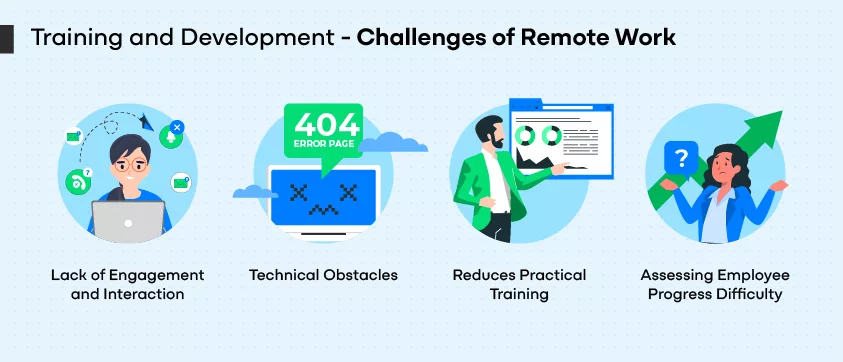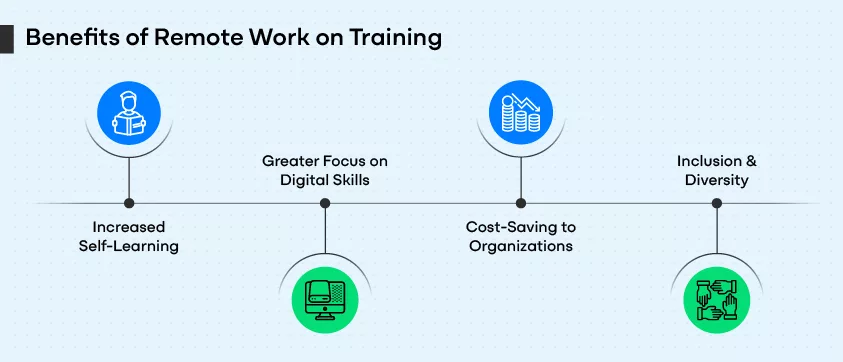Remote work has transformed the way businesses work by providing convenience and flexibility. However, it presents its own set of challenges regarding remote employee training.
Today, in-person training is not the only viable work model. Therefore, businesses resort to remote work alternatives to develop employee skills and increase productivity. This shift highlights the impact of remote employee training on engagement and productivity.
Let us look at the impact of remote work on training, the challenges it brings, and how organizations can provide effective learning environments to their remote workers.
Challenges of Remote Work in Training and Development

Remote working imposes some constraints on training and development. Companies struggle to achieve the same efficiency and skill development as their in-house team. Some of the main challenges of training remotely are described below:
Lack of Engagement and Interaction
In-person training creates a collaborative space, allowing participants to discuss issues, ask questions, and gain knowledge and experience from others. Remote work does not often provide this level of interactivity, which can result in disengagement or lower information retention.
Technical Obstacles
Ensuring all the employees have access to high-speed internet and high-class technology is a major challenge when training remotely. Some may face poor connectivity, software incompatibility, or have security questions about their privacy.
Reduces Practical Training
Several fields, such as manufacturing, healthcare, and engineering, require hands-on training in real-life scenarios. Remote learning is a good option in some situations. However, virtual simulations and online modules can’t provide the same experience as a workplace.
Assessing Employee Progress Difficulty
Determining employee progress is more complex in a remote setting than in a traditional work environment. Most employers rely on online quizzes or self-assessments that cannot accurately express an employee’s skill level or depth of understanding.
Training and Development in Remote Working
Employers now need to adopt new technologies to modify their training programs to adapt to the remote working environment. Read below to find out how businesses are tackling these challenges:
E-Learning Platforms
An increasing number of businesses are now going digital to provide learning management systems (LMS) with training modules. These track employee performance and award certifications. They also make it easier to upskill employees through Coursera, Udemy, and LinkedIn Learning, which help employees learn at their convenience and pace.
Virtual Training
Many companies are now adding interactive elements to training sessions. These include breakout rooms, quizzes, gamification, and live Q&A sessions to keep employees more engaged and help bridge the gap between classroom and virtual training.
Blended Learning Methods
This method includes live video training, online courses in individual, self-paced settings, and in-person workshops based on as-needed situations. A hybrid approach balances the flexibility of remote work with the benefits of in-person training.
Coaching and Peer-to-Peer Learning
Mentorship programs and peer learning should be promoted. The learning experience can easily be replicated with virtual mentoring sessions and group discussions similar to a normal working environment.
The Impact of Remote Work on Training

The long-term effects of training remote employees go beyond logistical challenges. Employers are proactively addressing these and changing the face of the corporate learning system with:
Increased Self-Learning
Employees get control over their learning schedule, and time. This flexibility has improved the output quality but requires higher levels of employee self-discipline.
Greater Focus on Digital Skills
The new remote working trends necessitate a better emphasis on digital skills. These digital skills range from collaboration tools to cybersecurity practice and data management systems.
Cost-Saving to Organizations
Costs of travel, location, and printed material are reduced. Virtual training saves companies from incurring costs for traveling and hiring locations and printed material. Businesses need to invest in an e-learning platform to enjoy their long-term benefits like cost savings.
Inclusion & Diversity
Remote working allows employees in different locations to benefit from the same learning products provided. This ensures a uniform experience and encourages inclusion in the workplace.
Best Practices for Training Remote Employees
Effective strategies can help to maximize remote employee training. Read below to find out more about them:
Engaging and Interactive Content
Videos, animations, and real-life case studies can make training sessions more engaging. When the content is visually appealing and interactive, employees are likely to retain more information.
Clear Learning Objectives
Remote workers should understand employer expectations and goals. This keeps them motivated to complete training programs.
Encourage Real-Time Feedback
It involves providing immediate feedback using quizzes, surveys, or even virtual check-ins to ensure that the employee learns and remains interested in the process.
Ongoing Training
Training is not just a one-time event. Updated training materials and ongoing learning opportunities help employees stay aligned with industry trends and skills.
Tailored Training Programs
Tailoring training to individual roles and skill levels makes learning more effective. Customizing content based on the needs of employees ensures the employees acquire relevant skills to perform their job functions.
Conclusion
Remote work has transformed corporate training by adding more opportunities. Businesses no longer use only traditional training. Leveraging technology, interactivity, and personalized programs increases the effectiveness of remote employee training experience. This addresses issues around engagement, accessibility, and development of the needed skills, helping businesses stand out in the modern digital-first workplace.
Therefore, businesses need to adapt to the latest technologies and trends to understand the impact of remote work on training. A well-trained employee will improve team performance and make the organization more skilled at handling the challenges of remote work for training and development.







